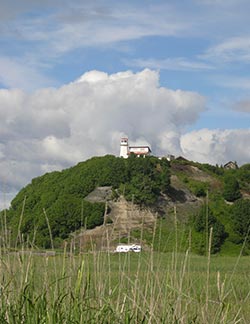Deep Creek State Recreation Area

©Helen O'Harra
Notable Species
- Chinook salmon
- Coho salmon
- Steelhead
- Harbor seal
- Surf scoter
- White-winged scoter
- Black scoter
- Common goldeneye
- Barrow’s goldeneye
- Bald eagle
- Sandhill crane
- Spotted sandpiper
- Gray jay
- Black-billed magpie
- Northwestern crow
Deep Creek emerges from the forest to meander across a broad salt marsh rimmed by wooded hillsides. Chinook salmon return to the creek in June and July, while coho salmon return in August and September. In May, the marsh fills with migrating shorebirds and waterfowl, as well as sandhill cranes. Several migratory bird species stay to nest in the marsh or along the hillside. The air fills with cries from bald eagles, overlooking the creek from perches in the large cottonwoods and birches. As many as 30 eagles have been spotted at one time during June and July evenings, as youngsters try their wings and adults watch for carcasses in the river. The edge between forest and marsh draws out sparrows, warblers, jays and magpies. Large numbers of gulls work the ocean beach to eat fish carcasses. Look for translucent, shrimp-like amphipods and other invertebrates under rocks along the sea shore. Cook Inlet’s waters take on a much stronger marine character from here south.
Habitat
The rock-strewn beach offers a glimpse of the intertidal world. The estuary and marsh extend a half mile inland, where the creek bottom transitions to a freshwater riparian zone. Cottonwood and birch forest dominates the edges overlooking the scene.
Recreation Connection
The Deep Creek State Recreation Area is one of the most popular sites for launching boats in pursuit of Cook Inlet halibut and Chinook salmon. The campground offers stunning views of the inlet and bird life. Canneries have operated along the creek since the early 20th century.
Viewing Tip
Pay attention to the rising tides. They inundate the lower river, dramatically altering the face of the beach and pushing shorebirds together. Visit during April and May to catch migrating birds, especially sandhill cranes. Northwestern crows seen here are part of the northernmost population of this species on the continent.
Getting There
Sterling Highway milepost 137.4. Turn at the Deep Creek State Recreation Area (signed).
